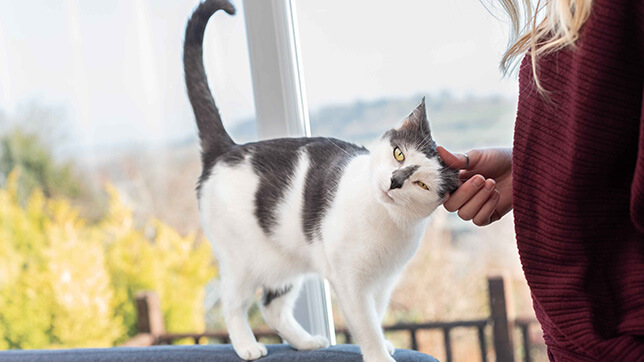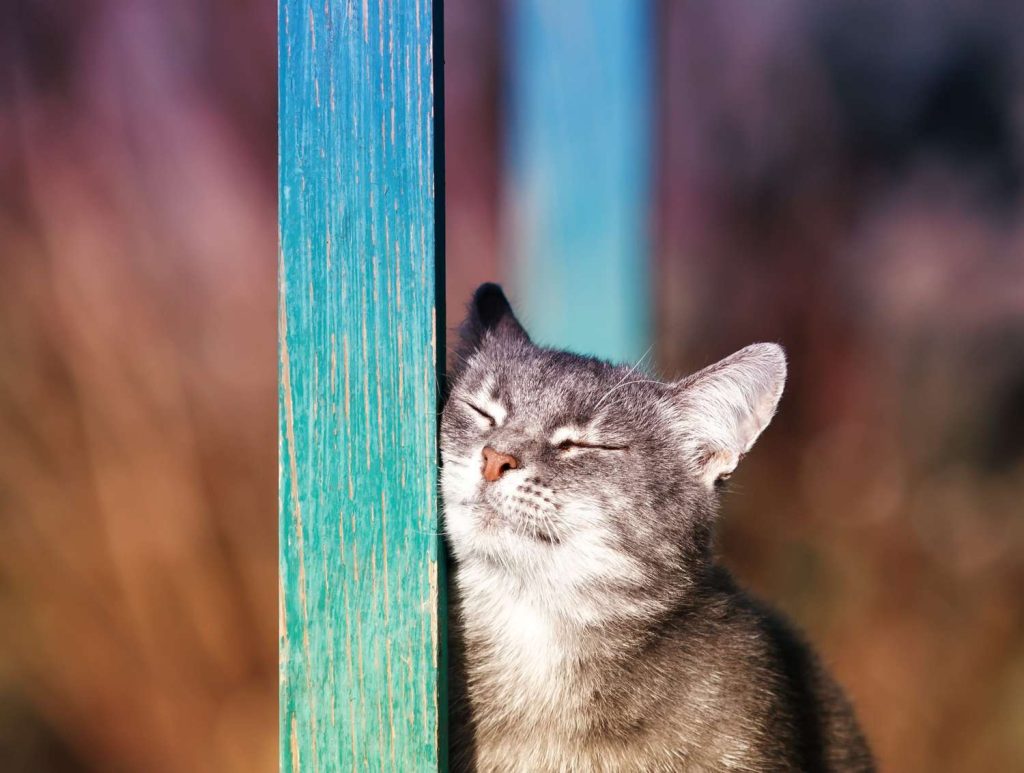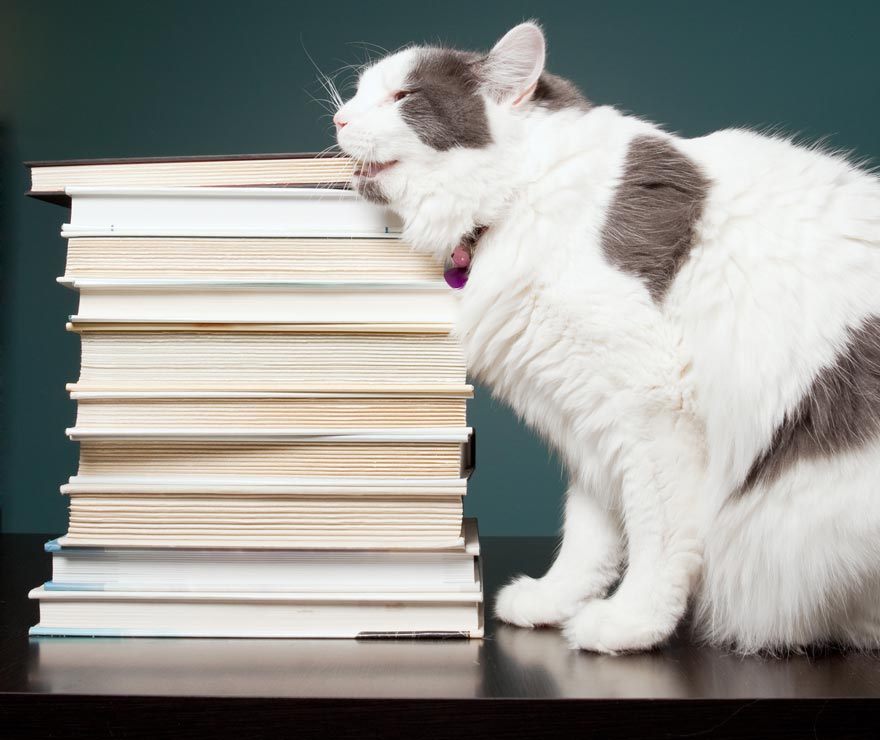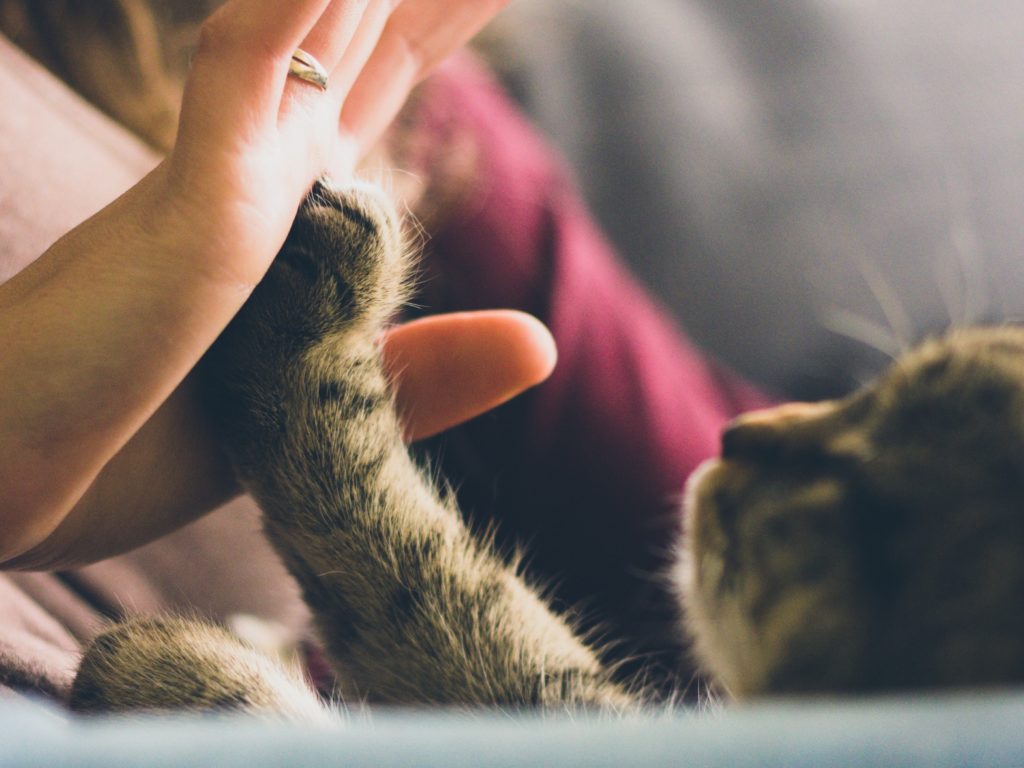Cats rub their faces on objects like phones as a way to mark territory with their scent, show affection, communicate trust, and mimic grooming behaviors.
Moreover, this behavior is called head bunting and is a unique form of nonverbal communication for cats. It’s a sign of comfort and bonding with you.
Why Are Cats Drawn to Objects Like Phones?
Cats are naturally curious creatures that are attracted to various objects in their environment. Objects like phones can pique their interest due to their unique characteristics and sensory stimuli.
Moreover, cats explore their surroundings through a combination of sight, smell, touch, and even taste, and phones offer a mix of these sensory experiences. Here are some reasons why cats might be drawn to phones:
- Novelty: Cats are intrigued by novel objects. A phone, with its different shape, materials, and textures, can be a new and interesting addition to their environment.
- Scent Triggers: Phones often carry scents from their owners due to frequent handling. Cats have a keen sense of smell, and the scent of a beloved human can make an object more appealing and comforting.
- Warmth: Phones can emit a slight amount of heat, especially when in use or recently used. Cats are drawn to warm spots as a source of comfort, which could make the phone a cozy place to rest against.
- Attention Seeking: Cats are masters at grabbing attention. If a cat notices that you frequently interact with your phone, they might try to engage with it as a way to redirect your focus onto them.
- Reflective Surfaces: Phones often have glossy screens that reflect light. Cats are naturally attracted to movement and light, so the reflective quality of the phone might catch their attention.
Potential Reasons: Scent, Warmth, and Texture

Scent: Cats have an extraordinary sense of smell and rely heavily on scent to gather information about their environment.
Moreover, when a cat rubs its face on your phone, they could be seeking out your scent. The oils and residue on the phone’s surface can carry your scent, which is comforting and reassuring for the cat.
Warmth: Cats are known for seeking out warm spots to rest. Phones, especially when in use, can generate a slight amount of heat.
In addition, the warmth from the phone can mimic the sensation of lying in a sunny spot, offering your cat a cozy and comfortable place to interact with.
Texture: The texture of a phone, with its smooth surfaces and varying materials, can provide tactile stimulation for cats.
On the other hand, cats often use their whiskers and sensitive facial areas to explore objects, and the textures of a phone can offer them a unique sensory experience.
Playfulness: Cats enjoy batting at and interacting with objects that capture their attention. The movement of your fingers on the phone’s screen, the sound of notifications, or even the vibrations can trigger a cat’s playful instincts.
What is the Significance of Head Bunting in Animal Behavior?
In the intricate realm of animal behavior, head bunting emerges as a fascinating and intimate form of interaction that unveils a world of communication beyond words.
Defining Head Bunting and its Common Name: “Head Butting”
Head bunting, also known as “head butting,” is a feline behavior characterized by a cat gently pressing its head against a person, object, or another animal.
Moreover, this behavior involves the cat making repeated contact with its forehead, cheeks, and sometimes the sides of its face. While the term “head butting” might imply force, in reality, this behavior is often quite gentle and affectionate.
This action may be accompanied by a rubbing or pushing motion, indicating a deliberate and purposeful interaction rather than an aggressive gesture.
In addition, the term “head bunting” is a more accurate representation of this behavior’s intent, which is more about marking, bonding, and communication than physical confrontation.
Scent Glands on the Face and Cheeks
Cats have specialized scent glands located on various parts of their bodies, with a notable concentration on their faces.
In addition, these scent glands are particularly prominent around the cheeks, the base of the ears, and the corners of the mouth. These glands produce pheromones, chemical substances that carry information and messages to other cats.
When a cat engages in head bunting, it’s essentially transferring its unique scent from these facial glands onto the object or individual being hunted.
Moreover, the cheeks and forehead, which come into direct contact during head bunting, are rich sources of these pheromones.
On the other hand, these scent marks convey a variety of messages, such as territorial ownership, familiarity, and even emotional states. Other cats can “read” these scent markings and gather important information about the bunting cat.
Scent Marking through Head Bunting
Head bunting is an instinctual way for cats to mark their territory and create a sense of ownership. By transferring their scent to objects or individuals, cats establish a connection between themselves and their environment.
Moreover, this is particularly important in multi-cat households or in outdoor environments where multiple cats might interact.
Additionally, head bunting serves as a form of communication beyond territorial marking. Cats might bunt each other as a way of confirming their social relationships, conveying a sense of comfort, and even showing submission.
Furthermore, when your cat head bunts you, it’s a display of trust and acceptance, signaling that it considers you a part of its social group.
What Are The Reasons Behind the Behavior?
Delving into the motivations behind this intriguing interaction uncovers a tapestry of social, physiological, and evolutionary drivers.
Affection and Bonding
Sign of Affection and Intimacy: Head bunting is a powerful way for cats to express affection and build intimacy with humans. When a cat engages in head bunting, it is initiating physical contact that goes beyond mere proximity.
In addition, this behavior signifies a level of comfort and closeness, as the cat is choosing to share its personal space with you. Moreover, the gentle nuzzling and rubbing of their head against you is a gentle and endearing gesture that demonstrates their positive feelings towards you.
Scent-Sharing for Bonding: Cats rely heavily on scent to recognize and bond with their surroundings, including people. When a cat head bunts you, they are transferring their scent onto you, effectively mingling their pheromones with yours.
Moreover, this mingling of scents creates a sense of familiarity and belonging. From the cat’s perspective, this action reinforces the idea that you are a part of their social group, promoting a stronger bond between you and your feline friend.
Communication and Trust
Nonverbal Communication: Cats communicate primarily through body language, and head bunting is a crucial component of this communication repertoire. Through head bunting, cats convey a variety of messages without the need for vocalizations.
Further, these messages can range from feelings of security and contentment to social hierarchy and even requests for attention or interaction.
Demonstration of Trust and Comfort: Trust is a fundamental aspect of a cat’s relationship with its human companion. When a cat’s head bunts you, it’s a clear indication that the cat feels safe and secure in your presence.
Additionally, this behavior is particularly noteworthy because cats are inherently cautious animals; they wouldn’t engage in such intimate physical contact if they didn’t feel trust and comfort around you.
Essentially, head bunting serves as a silent reassurance of the strong bond and understanding between you and your cat.
Mimicking Grooming Behaviors
Social Bonding through Grooming: Grooming is a significant social behavior among cats. Cats groom each other not only for hygiene but also to establish and reinforce social bonds within a group.
Additionally, grooming rituals help cats feel a sense of belonging and trust in their relationships with other cats. These behaviors are deeply rooted in their evolutionary history as pack animals.
Grooming-like Interaction in Head Bunting: Head bunting can be considered an extension of these grooming behaviors. When a cat head bunts you, it’s engaging in a form of social interaction reminiscent of the grooming rituals they share with other cats.
By using similar actions, cats are reinforcing their connection with you as if you were part of their feline social circle. Moreover, this behavior also mirrors the nurturing behavior of a mother cat grooming her kittens, further highlighting the care and affection they associate with head bunting.
How Can You Properly Monitor Changes in Behavior?
Cats have individual personalities and behaviors that can vary over time. While head bunting is generally a normal and positive behavior.
Moreover, it’s important to keep an eye out for any changes that might indicate underlying issues. Here’s why monitoring changes in behavior is essential:
Health Concerns: Sudden changes in behavior, including a sudden increase or decrease in head bunting, could be a sign of an underlying health issue. Cats might alter their behaviors if they are in pain or discomfort.
Stress and Anxiety: Cats are sensitive to changes in their environment, routine, or household dynamics. Furthermore, if your cat suddenly starts head bunting excessively or stops engaging in this behavior altogether, it could be due to stress or anxiety.
Social Interactions: However, if you have multiple cats, changes in head bunting behavior might be linked to shifts in social dynamics among the cats. Keep an eye on how the behavior corresponds to interactions between your cats.
When You Consult a Veterinarian for Excessive or Sudden Behavior?

Seeking the expertise of a veterinarian becomes crucial when confronted with sudden or excessive behaviors in your pets, as these shifts can be indicative of underlying health issues, emotional distress, or environmental factors.
Excessive Behavior: If your cat’s head bunting becomes obsessive, compulsive, or overly frequent, it’s worth seeking guidance from a veterinarian.
Moreover, excessive behavior can sometimes be linked to underlying medical conditions or anxiety.
Sudden Changes: Abrupt changes in behavior should always be taken seriously. If your cat suddenly stops head bunting when it used to be a common behavior or if the behavior becomes intense and aggressive, consult a veterinarian. These changes could be indicative of an issue that requires attention.
Medical Conditions: Some medical conditions, such as dental pain, ear infections, or skin irritations, can influence a cat’s behavior.
Moreover, a veterinarian can examine your cat and determine if any medical factors are contributing to the changes in behavior.
Behavioral Issues: A veterinarian experienced in feline behavior can also help you rule out or address any behavioral issues that might be at play.
Additionally, they can provide guidance on how to modify your cat’s behavior if needed.
FAQ’s
Why does my cat rub his face on my things?
Cats rub their faces on things to mark their territory with scent from facial glands, showing ownership and comfort.
Why does my cat rub her face on my laptop?
Cats rub their faces on objects for scent marking; your laptop carries your scent, making it familiar and reassuring.
How do you tell if your cat loves you?
Signs include head bunting, purring, slow blinking, and seeking physical closeness.
Do cats like it when you touch their face?
Some cats tolerate it, but many prefer gentle chin or cheek rubs over direct face touching.
Why do cats try to grab your face?
Cats might playfully grab faces as part of interactive behavior, curiosity, or seeking attention.
Why does my cat rub my legs when I’m on the toilet?
Cats seek closeness during vulnerable moments; leg rubbing is a comfort-seeking behavior.
Final Words
In conclusion, the behavior of cats rubbing their faces on objects like phones, known as head bunting or head butting, is a multifaceted and meaningful expression of their natural instincts and social dynamics.
Moreover, this behavior serves as a unique form of communication, bonding, and territory marking. Through the transfer of scent from facial glands, cats convey affection, trust, and a sense of belonging to their human companions.
Head bunting not only mirrors the social grooming practices seen among cats but also signifies a strong emotional connection.
Additionally, cats are drawn to objects like phones due to their innate curiosity, attraction to sensory stimuli, and the various elements these objects offer, such as scent, warmth, and texture.
However, it’s important to monitor changes in your cat’s behavior and seek professional guidance if there are sudden or excessive shifts. This vigilance helps ensure your cat’s physical and emotional well-being and fosters a deeper understanding of their individual needs and preferences.







